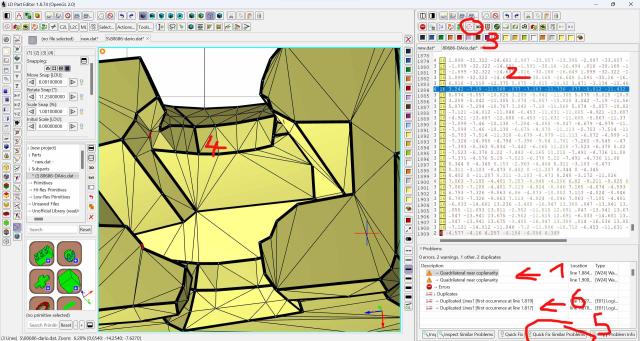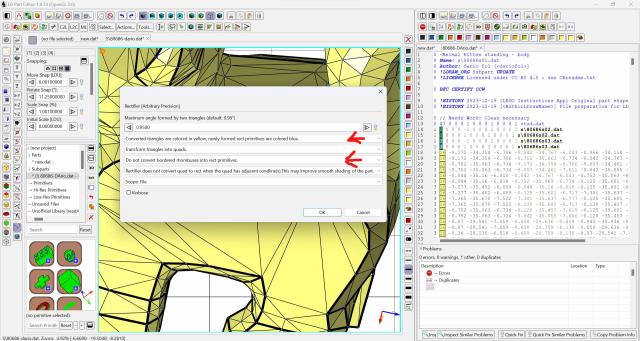* There are still some vertices that could be merged:
2 4 -4.452 -5.205 -4.373 -4.513 -4.519 -4.441
2 4 4.287 0 4.347 4.565 0 4.291
2 4 -4.577 -4.16 4.257 -4.184 -4.084 4.349

1. LDPE warns about quads near coplanarity, telling you also the line number:
4 16 3.242 -7.19 -11.568 .077 -7.183 -11.736 .077 -5.012 -11.432 3.209 -5.042 -11.305
double-click on the warning in the "Problems" pane
2. ... and it will show you the corresponding line in the Text Editor. Select the line ...
3. ... and click on "Show Selection in 3D View".
4. This will highlight the quad in the 3D view for further investigation what's wrong.
5. Luckily LDPE offers auto-correction for some errors. Just click "Quick Fix Similar Problems". Needless to say that you have double-check LDPE's fix with all automated processes.
6. Repeat the same with the "Duplicated line". Speaking of lines your kitten is still missing the lines around the tail's base which serve to highlight the steep angle in the mesh. That's why we also call them "Edges". They limit certain areas where the angle between triangle doesn't follow a smooth path.

* Time to run "Tools... -> Rectifier". To have more control over the process, let it color the generated quads.
* You'll note that I switched of "Do not convert bordered rhombuses into rect primitives". I'm not a big fan of rotated rects of all kind, 'cos they then to create gaps with touching triangles and quads because of rounding errors. Perfectly horizontal or vertical quads are fine, but then I let Rectifier convert them very selectively choosing what should be converted.
Finally run "Tools... -> Edger2" and post.
w.
2 4 -4.452 -5.205 -4.373 -4.513 -4.519 -4.441
2 4 4.287 0 4.347 4.565 0 4.291
2 4 -4.577 -4.16 4.257 -4.184 -4.084 4.349
1. LDPE warns about quads near coplanarity, telling you also the line number:
4 16 3.242 -7.19 -11.568 .077 -7.183 -11.736 .077 -5.012 -11.432 3.209 -5.042 -11.305
double-click on the warning in the "Problems" pane
2. ... and it will show you the corresponding line in the Text Editor. Select the line ...
3. ... and click on "Show Selection in 3D View".
4. This will highlight the quad in the 3D view for further investigation what's wrong.
5. Luckily LDPE offers auto-correction for some errors. Just click "Quick Fix Similar Problems". Needless to say that you have double-check LDPE's fix with all automated processes.
6. Repeat the same with the "Duplicated line". Speaking of lines your kitten is still missing the lines around the tail's base which serve to highlight the steep angle in the mesh. That's why we also call them "Edges". They limit certain areas where the angle between triangle doesn't follow a smooth path.
* Time to run "Tools... -> Rectifier". To have more control over the process, let it color the generated quads.
* You'll note that I switched of "Do not convert bordered rhombuses into rect primitives". I'm not a big fan of rotated rects of all kind, 'cos they then to create gaps with touching triangles and quads because of rounding errors. Perfectly horizontal or vertical quads are fine, but then I let Rectifier convert them very selectively choosing what should be converted.
Finally run "Tools... -> Edger2" and post.
w.
LEGO ergo sum










